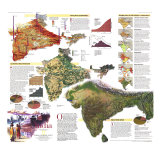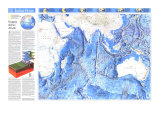The 1984 Peoples of South Asia map features:
• Illustrations and information about the diverse peoples who inhabit south Asia
• A map showing the range of various ethnic groups and languages
• An inset map with information about the religions of the region
• Country and province borders as well as major cities
• Mountain ranges, major rivers, and deserts are noted
• Map includes the Andaman and Nicobar Islands
• Notes about the caste system, official languages, Sikh unrest.
* Lesson plan idea - have your students update the information, discuss the political, economic, and environmental situations at time of publication and at date of their research. • maps
“Every two miles the water doth change and every four the dialect.” Hindi proverb.
PEOPLES OF SOUTH ASIA
Vicissitudes of history and variations of geography on the Indian subcontinent have created an intricately patterned cultrual fabric, woven but also rent along strands of language, religion, and caste. Over the nillennia, newcomers by land and by sea have added to the fabric's design–Aryans, Arabs, Turks, Afghans, Moguls, and British among others. The peoples of this distinctive world defy generalization.
Beginning some 3,500 years ago, Central Asians filtered in from the northwest, subjugating Dravidian speakers and bequeathing Sanskrit, source of most Indo-European languages in South Asia. Today in India alone there are 15 official written languages, hundreds more mother tongues, and countless dialects.
The birthplace of Hinduism and Buddhism and an exporter of Islam, soth Asia embraces a multitude of faiths. Hinduism's caste system of social tiers based on descent and occupation still orders Indian life, though less rigidly than before.
British administration tied the subcontinent together, but independence movements lead to the painful birth in 1947 of Islamic Pakistan from which Bangladesh split away in 1971, and the secular, predominantly Hindu, Republic of India.
The world's most populous democracy and a leading industrial power, nonaligned India contains three-quarters of South Asia's billion people. Like its neighbors, India confronts severe problems. The young nation struggles to maintain political integrity, control population growth, and improve the lot of its diverse peoples.
PAKISTAN & NORTH INDIA -
For thousands of years the passes of the Hindu Kush funneled waves of colonizers from Central and Western Asia. Virtually all 97 million Pakistanis and many Indians follow Islam, legacy of Muslim invasions that began in the eighth century.
Long the home of Punjabi and Sindhi farmers, the irrigated Indus Plain increasingly lures semi-nomads–the fiercely independent but hospitable Pathans and Baluchis–from the arid mountains. Purdah-observing Muslim women veil themselves from head to toe, but modern Punjabis prefer a trouser-shirt combination. Despite Islan's egalitarianism, Muslims retain social ranks; Sayyids are among the gentry.
Traditionally India's priests, Brahmans also work in the government and the professions. The enterprise of th Sikh Jats and the sweat of Chamars, largest of the once untouchable casts, help make India self-sufficient in grains. Too dry for a large farming population, Rajasthan gave rise to the the now widespread Marwari merchant castes. As laborers, brightly clad Rajasthani women recall tough medieval Rajput warriors.
HIMALAYAS -
A barrier but sometimes a bridge between India and China, the Himalayas (Sanskrit for “abode of snow”) fuse natural beauty and exotic peoples, derived from Central Asia, Tibet, and India. The soaring peaks and plunging valleys so isolate the populace that a herder-farmer in one valley may speak a different language from his neighbor in the next.
Kashmiris are renowned for their shawl weaving, using cashmere wool from mountain goats. Ladakhis, who speak a dialect of Tibetan, herd yaks, goats, and sheep, and coax crops of barley and buckwheat from irrigated terraces. In Nepal, Newars reap greater rewards in the lush Kathmandu Valley. Courageous, proud, and disciplined, the Gurkhas (a name misleadingly applied to all Nepalese soldiers) are recruited mainly from the Magar and Gurung peoples. The British and Indian Armies still count brigades of these fierce fighters. Life in the Kingdom of Bhutan, where serfdom was formally abolished in 1956, centers on land-rich monasteries once closely tied to Tibet.
EAST INDIA AND BANGLADESH -
Easterners are as varied as their land of forested hills, monsoon-drenched plains, and dissected tablelands. A score of Mongoloid Naga tribes, each with its own dialect, raise a range of crops by slash-and burn farming. Headhunters until recently, the Nagas constitute about 90 percent of Nagaland's population, and more than two-thirds are Christians. Also mostly Christian are the well educated Khasis. Some Khasis still erect megaliths to honor their dead. In steamy Bangladesh, with nearly 100 million people squeezed 1,800 to a square mile, Muslim farmers wear sarong-like lungis. Although separated by religion and nationhood, Bangladeshis and West Bengalis share geopgraphy and language. Through language Santals hope to preserve their tribal culture from inroads by land-hungry Bengali and Bihari peasants. The unclassifiable tongue of the fewer than 500 Sentinelese pygmies bespeaks their long isolation in the Andaman Islands.
SOUTH INDIA AND SRI LANKA -
The fragmented Deccan interior, which connects the mostly Indo-European north and the Dravidian south, shelters large agrarian casts, such as the Marathas, the tribes of Bhils and Gonds. Dry farming of millet contrasts with lowland wet=rice farming–as on the east coast of the Reddis, a major peasant caste, and the Oriyas. Like the Reddis and Marathas, the landowning Nairs extol their military past. The Tamils, with a cultural tradition of two millenia, take pride in their art, dance, and literature. English fares well among professional groups, especially the cosmopolitan Parsis of Bombay. Pre-Muslim Syrians brought Christianity to the kerala coast; Portuguese traders spread the faith in Goa and other maritime locations in the 1500s. Buddhists, active in Sri Lanka for more that 2,000 years, and Lingayats, whose sect emerged in India in the 12th century, represent a continuing rejection of the Brahman domination of Hinduism.
RELIGIONS OF SOUTH ASIA -
Hinduism, encompassing caste, ritual, and the worship of many gods, offers salvation through dharma, or right conduct. At its highest level, rarefied spiritual goals are attainable through meditation and asceticism. Buddhism promises enlightenment through meditation, while Jainism, another ancient Hindu reform, forbids the taking of life. Muslims believe in one God, Allah, whose law as revealed to the Prophet Muhammad is set forth in the Koran. Sikhism, an eglitarian synthesis of Islam and Hinduism, arose in the 15th century. In their fire temples Parisi kindle Zorastrianism, an ancient Persian faith. Christianity continues to win converts, especially among the tribes and the low castes.
~~~~~~~~~~~~~~~
|
Heinrich Zimmer
b. 12-6-1890; Greifswald, Germany
d. 3-20-1943; New York
Historian and professor Heinrich Zimmer was an Indologist specializing in South Asian art. He is most known for his works, Myths and Symbols in Indian Art and Civilization and Philosophies of India, that were edited for posthumous publication by Joseph Campbell.
Heinrich Zimmer quote ~
• “Truth appears differently in different lands and ages according to the living materials out of which its symbols are hewn.” Philosophies of India
|













